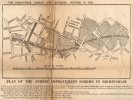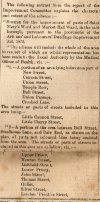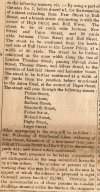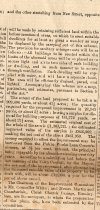Shortly after the Birmingham Archaeological Society (associated with the Midland Institute) was formed in 1870 they purchased some drawings of Birmingham streets, and by 1872 there were 75 recorded as being owned. By 1893 they seem to have been forgotten, but 17 were found in a “tin box”, and, in 1939 the Transactions of the Society published a short article on the drawings (Walker, Benjamin; Trans. Birm.Archeol.Soc. (1939-30) 63, 33-40 ) which included 6 of the views. I presume these views are now somewhere in the depths of the Reference library. In this thread I will be commenting on the six views. All the views seem more alive than the photographs of the time, probably because in photographs, because of the slow speed of films, people either were blurs/ not seen, or like statues, keeping still deliberately.
Livery St, west side between Colmore Row & Edmund St
The first is described as above. Looking at directories available (1862,1867,1868,1872) would place the drawings as being made after the situation listed in Post Office directory of 1868, but before the equivalent of 1872 (remembering that, in earlier directories, the dates given in the title can be a little later than the information described therein). Below I have incorporated the numbers of the buildings in the street in red at the top of the drawing. In fact the drawing does not show the complete set of buildings in this range, as 1 & 2 do not appear to be shown, and the numbering goes up to at least 19 before Edmund St, and the drawing only shows 17. Possibly the end of the row was open land at this time. The numbering at the other end is not so clear (so no numbering is added), as no names are on the buildings. In the 1839 map of the area shown, there is an inset from the street not present on the drawing, so this end has obviously been rebuilt since then. In any case the c1889 OS map (probably actually about 1884) shows that all the old buildings have gone, and the area has, as yet, only partly been rebuilt. On these two maps I have shown by a red line the approximate length of the drawing being discussed. There are a couple of inconsistencies but most of the drawing agrees with the directories.
The drawing shows:
5 & 6 is Thomas Watts, tobacconist. In the 1867 directory Watts was only at no 5 and Henry Cumberland, carver & gilder, was at no 6, but Watts occupied both in the 1872 edition.
7 & 8 are occupied by James Moore Clements, tailor, though from the adverts on the front of the shop, he also sells tailoring supplies such as needles and parts for tailoring machines. By 1872 the building is occupied by Frederick Palfrey, ticket writer. This apparently (https://www.photohistory-sussex.co.uk/BTN-LaneWm.htm) was a person who drew out tickets for shop and other trade windows, showing special offers etc and this reference shows a picture of one at work.
9 & 10 is Josiah Allen, printer & stationer, though he seems to have disappeared by 1872.
11. Although no indication is given as to the occupant, no 11 appears to be occupied for the whole period by Joseph Hackwood, also a ticket writer.
No 12 is Bodington, late Davis. In 1867-8 John Davis, butcher occupied the building. I can find no Bodington listed with only one D, and no Boddington who was a butcher, but presumably he did not last long as a business and so did not appear in any of the above directories.
13. On the drawing this seems to be a newsagent, from sign “News2 on wall. In 1868 he is listed as Joseph Mason, tobacconist, but these may well have sold papers also. He does not appear in 1867 or 1872, and is listed as Harry Underhill, tobacconist in 1862.
14 is the Albion wine Vaults. Run by Henry Herridge since the early 1850s, it seems that, when he first ran it, it was called the Waggon & Horses, and the street numbering was different. On the 1880s OS map below, after the area has been rebuilt, there is still an Albion commercial hotel, run by Henry Herridge, but this is now at no. 23, on the corner of, and the other side of, Edmund St.
15. James Storer, general engraver for the whole of this period.
16. You can just read Collins above "Gun" and "pistol". William Collins, gun 7 pistol maker is there in 1868 and 1872.
17. John Hall, harness maker is listed there 1862 till at least 1872.



Livery St, west side between Colmore Row & Edmund St
The first is described as above. Looking at directories available (1862,1867,1868,1872) would place the drawings as being made after the situation listed in Post Office directory of 1868, but before the equivalent of 1872 (remembering that, in earlier directories, the dates given in the title can be a little later than the information described therein). Below I have incorporated the numbers of the buildings in the street in red at the top of the drawing. In fact the drawing does not show the complete set of buildings in this range, as 1 & 2 do not appear to be shown, and the numbering goes up to at least 19 before Edmund St, and the drawing only shows 17. Possibly the end of the row was open land at this time. The numbering at the other end is not so clear (so no numbering is added), as no names are on the buildings. In the 1839 map of the area shown, there is an inset from the street not present on the drawing, so this end has obviously been rebuilt since then. In any case the c1889 OS map (probably actually about 1884) shows that all the old buildings have gone, and the area has, as yet, only partly been rebuilt. On these two maps I have shown by a red line the approximate length of the drawing being discussed. There are a couple of inconsistencies but most of the drawing agrees with the directories.
The drawing shows:
5 & 6 is Thomas Watts, tobacconist. In the 1867 directory Watts was only at no 5 and Henry Cumberland, carver & gilder, was at no 6, but Watts occupied both in the 1872 edition.
7 & 8 are occupied by James Moore Clements, tailor, though from the adverts on the front of the shop, he also sells tailoring supplies such as needles and parts for tailoring machines. By 1872 the building is occupied by Frederick Palfrey, ticket writer. This apparently (https://www.photohistory-sussex.co.uk/BTN-LaneWm.htm) was a person who drew out tickets for shop and other trade windows, showing special offers etc and this reference shows a picture of one at work.
9 & 10 is Josiah Allen, printer & stationer, though he seems to have disappeared by 1872.
11. Although no indication is given as to the occupant, no 11 appears to be occupied for the whole period by Joseph Hackwood, also a ticket writer.
No 12 is Bodington, late Davis. In 1867-8 John Davis, butcher occupied the building. I can find no Bodington listed with only one D, and no Boddington who was a butcher, but presumably he did not last long as a business and so did not appear in any of the above directories.
13. On the drawing this seems to be a newsagent, from sign “News2 on wall. In 1868 he is listed as Joseph Mason, tobacconist, but these may well have sold papers also. He does not appear in 1867 or 1872, and is listed as Harry Underhill, tobacconist in 1862.
14 is the Albion wine Vaults. Run by Henry Herridge since the early 1850s, it seems that, when he first ran it, it was called the Waggon & Horses, and the street numbering was different. On the 1880s OS map below, after the area has been rebuilt, there is still an Albion commercial hotel, run by Henry Herridge, but this is now at no. 23, on the corner of, and the other side of, Edmund St.
15. James Storer, general engraver for the whole of this period.
16. You can just read Collins above "Gun" and "pistol". William Collins, gun 7 pistol maker is there in 1868 and 1872.
17. John Hall, harness maker is listed there 1862 till at least 1872.





























